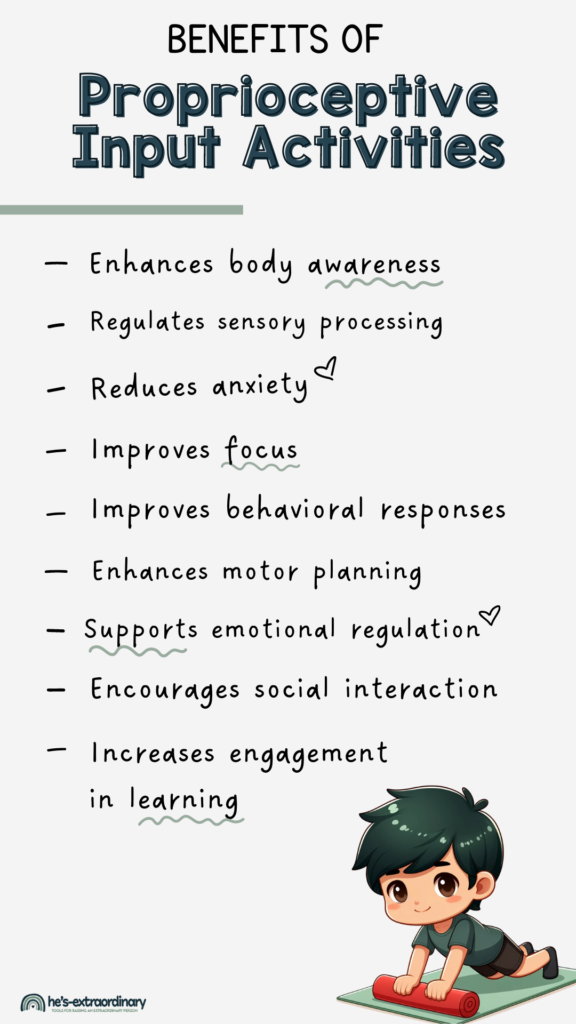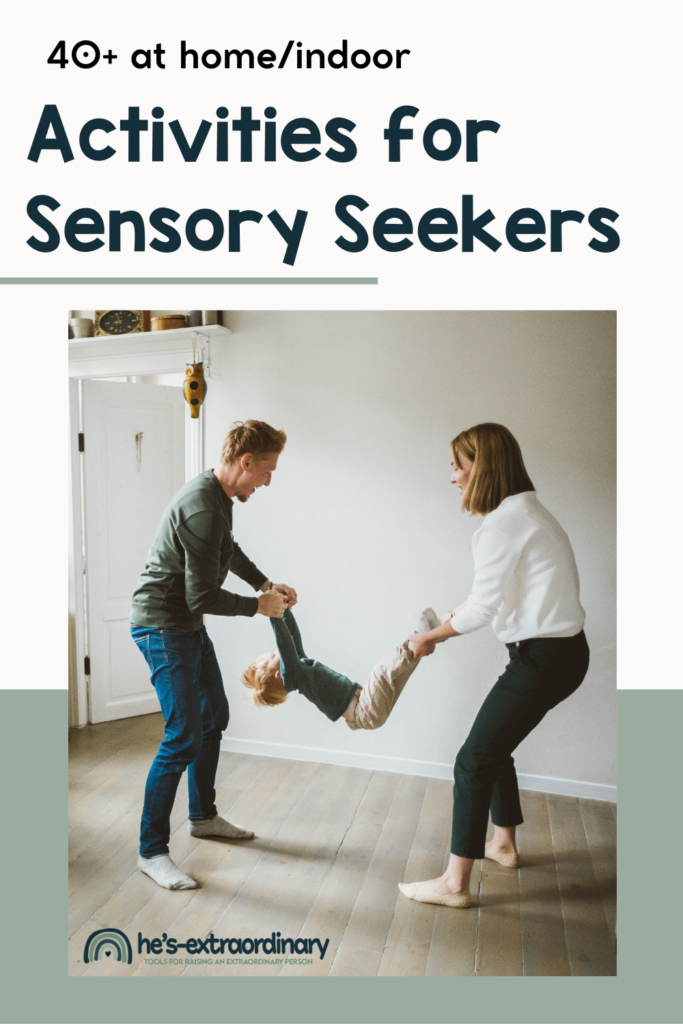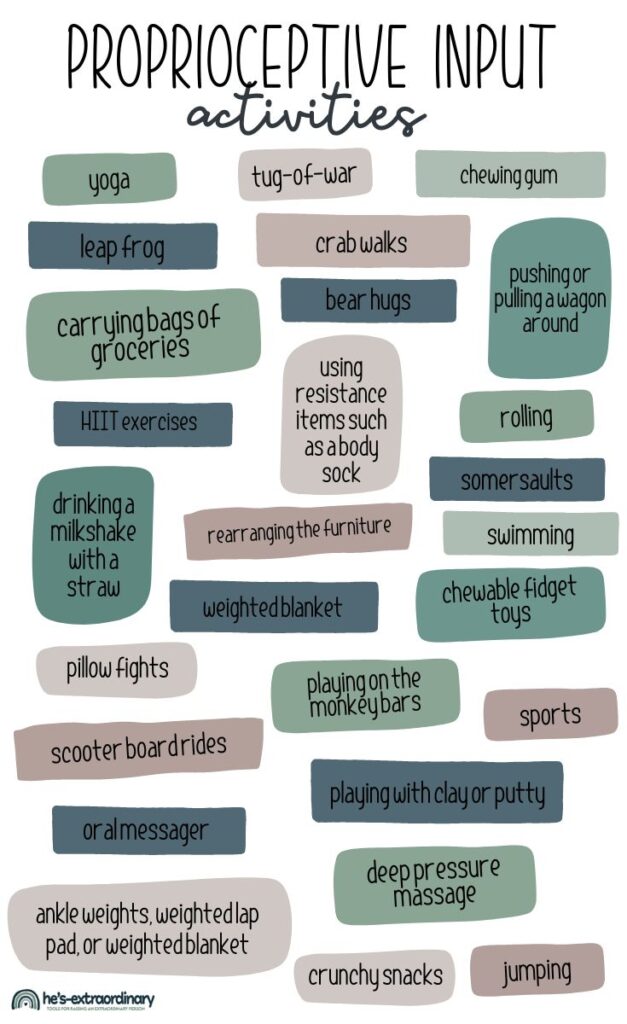49 Proprioceptive Input Activities for Sensory Seekers
What’s inside this article: Proprioceptive input activities are designed to help individuals, including kids with autism, understand where their bodies are in space. This article covers signs of sensory processing challenges, and a list of 40+ proprioceptive input activities.
Disclaimer: This post contains affiliate links.
Recently, I published a series on the different sensory systems, including proprioception. If you’d like to learn about what proprioception is and how it works, click here
This post is diving into more information on daily activities for kids that offer proprioceptive input. Evidence shows this can help tremendously with sensory-seeking behaviors, avoidance, and preventing meltdowns.
Proprioceptive Input and Autism
It is common for children and adults with autism to have atypical sensory processing. In fact, 95% of people with autism have sensory processing differences in at least one of the seven senses.; meaning one or more of their senses are over or under-reactive to stimuli.
The senses include the well-known five senses: smell, taste, touch, sound, and sight, as well as the less commonly mentioned senses: vestibular (inner ear), proprioception,
Proprioceptive input activities can be significantly beneficial for kids with autism for several reasons related to how their bodies process sensory information. The proprioceptive system involves receptors in the muscles, joints, and ligaments that provide information about body position, movement, and the force of muscle contractions.
Benefits of Proprioceptive Input Activities
- Enhances body awareness
- Regulates sensory processing
- Reduces anxiety
- Improves focus
- Improves behavioral responses
- Enhances motor planning
- Supports emotional regulation
- Encourages social interaction
- Increases engagement in learning

Signs of proprioceptive challenges include:
Children who are struggling with proprioceptive challenges may have difficulties in processing and responding to sensory information related to body position, movement, and force.
This can manifest in various ways, impacting their motor skills, behavior, and daily activities.
Here’s a list of signs that may indicate a child is struggling with proprioceptive challenges:
- Poor Motor Coordination: Difficulty with tasks that require coordination, such as catching a ball, jumping, or climbing stairs.
- Clumsiness: Frequent tripping, bumping into objects, or falling down.
- Difficulty Grasping the Strength of Their Own Movements: May not understand their own strength, leading to actions that are too forceful or too gentle. For example, they might press too hard with a pencil while writing or not hard enough.
- Challenges with Fine Motor Skills: Problems with tasks requiring delicate hand movements, such as buttoning clothes or using utensils.
- Difficulty with Spatial Awareness: Trouble understanding where their body is in relation to other objects or people, leading to personal space issues.
- Seeking Intense Pressure: Might prefer tight hugs, enjoy heavy blankets, or frequently seek out situations where they can experience deep pressure against their body. This could include rough play.
- Avoidance of Physical Activities: May avoid playground activities, sports, or any tasks that require coordinated movement.
- Overreliance on Visual or Other Sensory Inputs: To compensate for poor proprioception, they might need to watch their movements closely, like watching their feet while walking or touching walls and furniture for guidance while moving.
- Difficulty with Navigation: Challenges in moving through crowded or unfamiliar spaces without bumping into things.
- Excessive Chewing or Biting: Chewing on non-food items, clothing, or fingernails might be a way to seek proprioceptive input in the jaw.
- Unusual Posture or Gait: May stand or walk in awkward positions due to not having a good sense of body alignment.
- Difficulty Adjusting Force for Tasks: Such as slamming doors when trying to close them gently or being unable to judge the amount of force needed for tasks like pouring a drink without spilling.
- Poor Balance: Difficulty maintaining balance, especially when eyes are closed or when standing on one foot.
- Seeking or Avoiding Movements: Either excessively seeking movements, like spinning or jumping, or avoiding movements and activities that most children find enjoyable.
- High Pain Tolerance or Sensitivity: May not respond to injuries as expected, either showing little reaction to something that would typically be painful or reacting strongly to minor bumps.
- Trouble with Body Awareness Exercises: Such as difficulty imitating movements, struggling with yoga poses, or not knowing where their limbs are without looking.
Some autistic adults have even described it as feeling as though their bodies are floating with no awareness of where their bodies are in space if they aren’t receiving enough proprioceptive input.
Helping Children with Sensory Challenges
Children displaying these signs may benefit from an evaluation by an occupational therapist, who can provide strategies and interventions to help improve their proprioceptive processing.
Interventions often involve specific activities designed to provide the proprioceptive input the child needs to feel more comfortable and capable in their movements and interactions with their environment. However, there are many fun activities parents and educators can introduce to their children at home and school.
Engaging in activities that provide proprioceptive input to your children helps with body awareness, relieves some of the stress caused by sensory processing challenges, and improves self-regulation.
Planned proprioceptive input activities throughout the day can improve sensory integration and emotional regulation and also prevent inappropriate sensory-seeking behaviors.
Proprioceptive Input Activities

What are the best kinds of activities for proprioceptive input?
Activities that involve heavy lifting or pushing, stretching or compression, or deep pressure are all great ways to stimulate the proprioceptive system.
Heavy work activities can include household chores such as vacuuming and mopping, outdoor playground activities, animal crawls and walks, using weighted blankets/vests, jumping on a trampoline, etc.
Whole-body activities provide the most stimulation, but other activities like drinking a thick milkshake from a straw or squeezing a stress ball also give proprioceptive input.
I’ve created a list of simple activities that children can do every day. Occupational therapists recommend short but frequent sensory breaks through the day, rather than longer but less frequent periods of activity.
1. Fun Movements
Take a 5-minute movement break every 1-2 hours and engage in one of these fun, whole-body movements:
- Yoga – Get a free printable poster of kids’ yoga poses
- LeapFrog
- Wheel Barrel Walking
- Crab Walks
- Gorilla Jumps
- Stretches
- Somersaults
- Cartwheels
- Jumping
- Rolling (down a hill, on a mat)
- This 7-minute kids work out
- This gross motor game is excellent for days when you’re stuck inside the house.
- 8-minute workout for kids
- Dinosaur workout for kids
2. Oral-Motor Activities
These don’t give as much stimulation as a full-body movement activity but may be helpful in situations where your child needs to sit still for a bit (school, doctor’s waiting rooms, etc.).
This is because there are proprioceptors in the jaw.
- Chew gum
- Eat crunchy foods like baby carrots or celery
- Drink a thick milkshake through a straw
- Drink applesauce through a straw
- Use chew fidgets – these ones are my personal favorite
- Try a chewable oral massager
3. Fun Activities
These are simple activities that require an object or prop to play.
Most of these activities can be done at home.
- Pillow fights
- Skipping rope
- Scooter board – Have your child sit on the board and hold onto a pool noodle while you pull them around.
- Sandbox play
- Swinging and Monkey bars at the playground
- Using a crash pad – These are AMAZING. If you’ve got a lot of stuffies in your home, you can fill up one of these, and then you have your own crash pad that doubles as a storage system.
- Playing with resistance items – like a body sock, a cuddle loop, or a resistance tunnel like this one.
- Jumping on a trampoline – trampolines have so many benefits. If you’re tight on space, this trampoline folds up flat for easy storage.
- Squishing – Get your child to lie on the floor and “squish them” by rolling a large exercise ball over them.
- Tug of War
- This kid-sized non-motorized treadmill is perfect for times when you’re stuck in the house, and your kids are bouncing off the walls.
- Swimming – swimming provides proprioceptive input to the whole body because the density of the water adds extra pressure to your body.
4. Sports
All sports involve movement and exercise that stimulate the proprioceptive system. This doesn’t mean you need to enroll your child in an organized sport, but if they’re interested, it’s a great way to incorporate social interaction and proprioceptive input.
If your child isn’t interested in organized sports, you can still play sports games with them one-on-one or in small groups.
For example:
- Dodgeball
- Playing catch
- Throwing a frisbee
- Kicking a soccer ball at the park
- Tag: There are many different types of tag games
- Individual sports like jiu-jitsu, muay thai, tennis, snowboarding, paddleboarding
5. Heavy Work Activities
These are all activities that involve pushing, pulling, lifting, etc., that stimulate the proprioceptors in the muscles and joints.
- Wagon rides – Great for siblings. Have them take turns pushing and pulling each other in a wagon.
- Gardening – Have children help you pull weeds, dig, and water the plants. These tasks all involve heavy work.
- Carrying in the groceries – It may be a chore, but it’s also a great way to give your child a bit of responsibility, heavy work, and positive reinforcement for helping you out. My kids all love helping with the groceries.
- Play with a medicine ball – roll, throw, carry, etc. Just make sure that it isn’t too heavy for your child.
- Lifting weights – Ensure this activity is age-appropriate, but have your child join you when you work out. It’s a great way to foster a healthy lifestyle as well.
Read: 57 Heavy Work Activities
6. Therapeutic Items
These are therapeutic tools that can help provide additional proprioceptive input during the day. These items may be used by an occupational therapist but can be used at home too.
- Weighted blanket
- Ankle Weights – These can be used on the palms or the ankles
- Stress ball – check out these silly emoji stress balls
- Deep pressure massage – Deep pressure provides proprioceptive input, and deep pressure massage can also help kids with tactile defensiveness who have sensory issues to clothing.
- Therapy putty, silly putty, etc – this stuff is super cool.
- Other weighted items like vests or weighted lap/shoulder pads.
Children with sensory processing differences may lack the awareness to know where they are in time and space.
It’s why they may seem never to stop moving or are always crashing into things- they’re trying to get grounded by seeking proprioceptive input.
Activities that provide proprioceptive input can help give them that grounding and increase body awareness. It’s an integral part of a sensory diet, so get ready to have some fun with your sensory-seeking kiddos!
Don’t forget to check out how kids can calm down by hanging upside down and learn about


